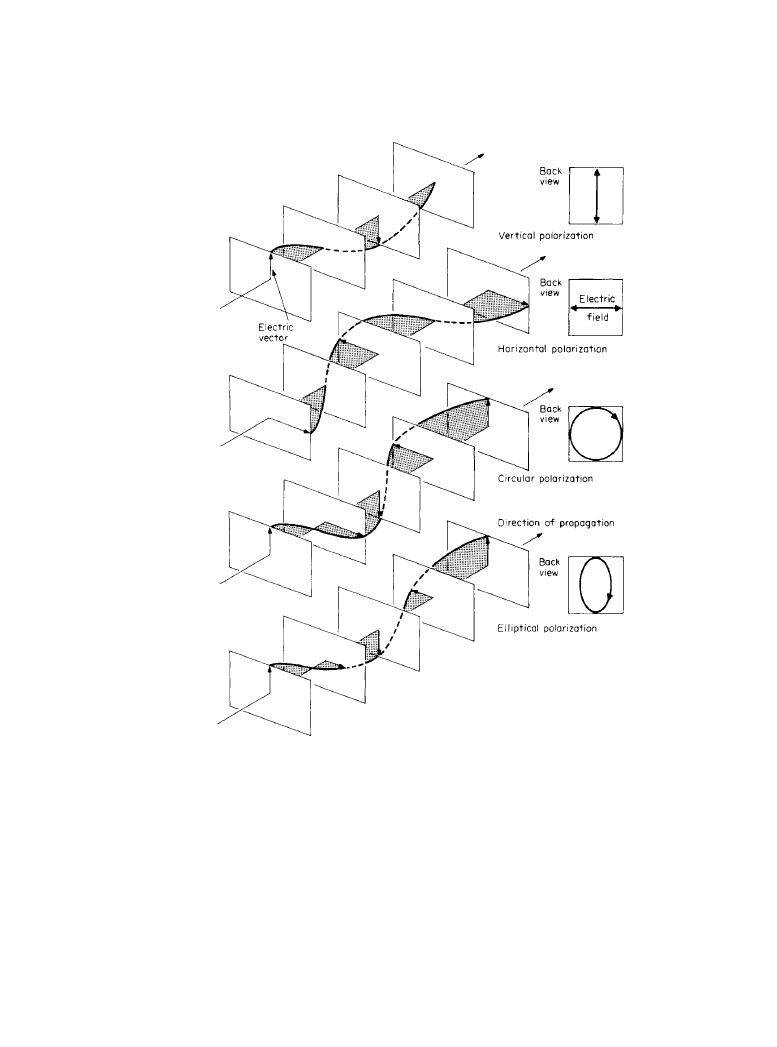ВУЗ: Казахская Национальная Академия Искусств им. Т. Жургенова
Категория: Книга
Дисциплина: Не указана
Добавлен: 03.02.2019
Просмотров: 21656
Скачиваний: 19

Downloaded from Digital Engineering Library @ McGraw-Hill (www.digitalengineeringlibrary.com)
Copyright © 2004 The McGraw-Hill Companies. All rights reserved.
Any use is subject to the Terms of Use as given at the website.
Radio STL Systems

11-103
Chapter
11.5
Transmitting Antennas
Jerry C. Whitaker, Editor-in-Chief
11.5.1 Introduction
Transmission is accomplished by the emission of coherent electromagnetic waves in free space
from one or more radiating elements that are excited by RF currents. Although, by definition, the
radiated energy is composed of mutually dependent magnetic and electric vector fields, it is con-
ventional practice to measure and specify radiation characteristics in terms of the electric field
only.
The purpose of an antenna is to radiate efficiently the power supplied to it by the transmitter.
A simple antenna, consisting of a single vertical element over a ground plane can do this job
quite well at low-to-medium frequencies. Antenna systems may also be required to concentrate
the radiated power in a given direction and minimize radiation in the direction of other stations
sharing the same or adjacent frequencies. To achieve such directionality may require a compli-
cated antenna system that incorporates a number of individual elements or towers and matching
networks.
As the operating frequency increases into VHF and above, the short wavelengths permit the
design of specialized antennas that offer high directivity and gain.
11.5.2 Operating Characteristics
Wavelength is the distance traveled by one cycle of a radiated electric signal. The frequency of
the signal is the number of cycles per second. It follows that the frequency is inversely propor-
tional to the wavelength. Both wavelength and frequency are related to the speed of light. Con-
version between the two parameters can be accomplished with the formula
Where:
c = speed of light
f = operating frequency
w = wavelength
c
f
w
×
=
Downloaded from Digital Engineering Library @ McGraw-Hill (www.digitalengineeringlibrary.com)
Copyright © 2004 The McGraw-Hill Companies. All rights reserved.
Any use is subject to the Terms of Use as given at the website.
Source: Standard Handbook of Audio and Radio Engineering

11-104 Broadcast Transmission Systems
The velocity of electric signals in air is essentially the same as that of light in free space (2.9983
× 10
-10
cm/s).
The electrical length of a radiating element is the most basic parameter of an antenna.
Where:
H = length of the radiating element in electrical degrees
H
t
= length of the radiating element in feet
F
o
= frequency of operation in kHz
When the radiating element is measured in meters
The radiation resistance of an antenna is defined by the equation
Where:
R = radiation resistance
P = power delivered to the antenna
I = driving current at the antenna base
11.5.2a
Antenna Bandwidth
Bandwidth is a general classification of the frequencies over which an antenna is effective. This
parameter requires specification of acceptable tolerances relating to the uniformity of response
over the intended operating band.
Strictly speaking, antenna bandwidth is the difference in frequency between two points at
which the power output of the transmitter drops to one-half the midrange value. These points are
called the half-power points. A half-power point is equal to a VSWR of 5.83:1, or the point at
which the voltage response drops to 0.7071 of the midrange value. In most communications sys-
tems a VSWR of less than 1.2:1 within the occupied bandwidth of the radiated signal is prefera-
ble.
Antenna bandwidth depends upon the radiating element impedance and the rate at which the
reactance of the antenna changes with frequency. Bandwidth and RF coupling go hand in hand
regardless of the method used to excite the antenna. All elements between the transmitter output
circuit and the antenna must be analyzed, first by themselves, then as part of the overall system
bandwidth. In any transmission system, the composite bandwidth, not just the bandwidths of
individual components, is of primary concern.
H
H
t
F
o
2733
------------
=
H
H
t
F
o
833.23
----------------
=
R
P
I
2
----
=
Downloaded from Digital Engineering Library @ McGraw-Hill (www.digitalengineeringlibrary.com)
Copyright © 2004 The McGraw-Hill Companies. All rights reserved.
Any use is subject to the Terms of Use as given at the website.
Transmitting Antennas

Transmitting Antennas 11-105
11.5.2b Polarization
Polarization is the angle of the radiated electric field vector in the direction of maximum radia-
tion. Antennas may be designed to provide horizontal, vertical, or circular polarization. Horizon-
tal or vertical polarization is determined by the orientation of the radiating element with respect
to earth. If the plane of the radiated field is parallel to the ground, the signal is said to be horizon-
tally polarized. If it is at right angles to the ground, it is said to be vertically polarized. When the
receiving antenna is located in the same plane as the transmitting antenna, the received signal
strength will be maximum.
Circular polarization (CP) of the transmitted signal results when equal electrical fields in the
vertical and horizontal planes of radiation are out-of-phase by 90° and are rotating a full 360° in
one wavelength of the operating frequency. The rotation can be clockwise or counterclockwise,
depending on the antenna design. This continuously rotating field gives CP good signal penetra-
tion capabilities because it can be received efficiently by an antenna of any random orientation.
Figure 11.5.1 illustrates the principles of circular polarization.
11.5.2c
Antenna Beamwidth
Beamwidth in the plane of the antenna is the angular width of the directivity pattern where the
power level of the received signal is down by 50 percent (3 dB) from the maximum signal in the
desired direction of reception.
11.5.2d
Antenna Gain
Directivity and gain are measures of how well energy is concentrated in a given direction. Direc-
tivity is the ratio of power density in a specified direction to the power density that would be pro-
duced if the energy were radiated isotropically. The reference can be linearly or circularly
polarized. Directivity is usually given in dBi (decibels above isotropic).
Gain is the field intensity produced in a given direction by a fixed input power to the antenna,
referenced to a dipole. Gain is frequently used as a figure of merit. Gain is closely related to
directivity, which in turn is dependent upon the radiation pattern. High values of gain are usually
obtained with a reduction in beamwidth.
An antenna is typically configured to exhibit “gain” by narrowing the beamwidth of the radi-
ated signal to concentrate energy toward the intended coverage area. The actual amount of energy
being radiated is the same with a unity gain antenna or a high gain antenna, but the useful energy
(commonly referred to as the effective radiated power, or ERP) can be increased significantly.
Electrical beam tilt can also be designed into a high gain antenna. A conventional antenna
typically radiates more than half of its energy above the horizon. This energy is lost for practical
purposes in most applications. Electrical beam tilt, caused by delaying the RF current to the
lower elements of a multi-element antenna, can be used to provide more useful power to the ser-
vice area.
Pattern optimization is another method that may be used to maximize radiation to the
intended service area. The characteristics of the transmitting antenna are affected, sometimes
greatly, by the presence of the supporting tower, if side-mounted, or by nearby tall obstructions
(such as another transmitting tower) if top-mounted. Antenna manufacturers use various meth-
ods to reduce pattern distortions. These generally involve changing the orientation of the radia-
tors with respect to the tower, and adding parasitic elements.
Downloaded from Digital Engineering Library @ McGraw-Hill (www.digitalengineeringlibrary.com)
Copyright © 2004 The McGraw-Hill Companies. All rights reserved.
Any use is subject to the Terms of Use as given at the website.
Transmitting Antennas

11-106 Broadcast Transmission Systems
11.5.2e
Space Regions
Insofar as the transmitting antenna is concerned, space is divided into three regions:
•
Reactive near-field region. This region is the area of space immediately surrounding the
antenna in which the reactive components predominate. The size of the region varies, depend-
ing on the antenna design. For most antennas, the reactive near-field region extends 2 wave-
lengths or less from the radiating elements.
Figure 11.5.1
Polarization of the electric field of a transmitted wave.
Downloaded from Digital Engineering Library @ McGraw-Hill (www.digitalengineeringlibrary.com)
Copyright © 2004 The McGraw-Hill Companies. All rights reserved.
Any use is subject to the Terms of Use as given at the website.
Transmitting Antennas